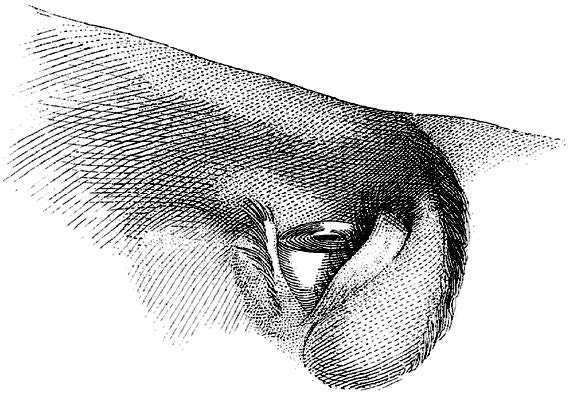I have recurring dream in which I’m late for a party and I’m trying to put my contacts in. I’m having a problem, because these are not my usual, waking-life contacts. They’re big as fried eggs. Sometimes they’re rigid and made of the wrong material— drift wood, melamine, ice. One dream had me trying to fit an entire paperback in there. It wasn’t a thick book—Siddhartha comes to mind—but I had a hell of a time, and my friends left for the party without me.
A while ago I was visiting a mortuary college, because I was working on a book about cadavers, and I came across what looked to be a contact lens straight out of one of these dreams. Technically, it wasn’t a lens, as it couldn’t change the wearer’s vision, or anyway not in a positive manner. The morticians called it an “eye cap.” It was about the diameter of a cocktail olive and made of rigid plastic with perforations partway through. The perforations form little pointy, spurlike chads, which work on the same principle as those steel spikes that threaten Severe Tire Damage on behalf of rental-car companies. An eyelid will come down over an eye cap, but, once closed, won’t open back up. The instructor explained that eye caps “help the decedent keep his eyes closed.” (I love mortuary euphemisms. “Decedent” turns a dead, decomposing human into something benign and academic; it’s like you die and become a legal term.)
I started poking around in the drawers, and I found all kinds of tools that seemed to belong in someone’s bad dream. There were nasal aspirators and “natural expression formers.” At the same time as they were scary, they were also, you had to admit, clever. Morticians seem to have a flair for inventing simple, surreal gadgets to make their jobs easier. (Every now and then, one of them wanders off the path of common sense and practicality. Thomas Holmes, the socalled Father of Modern Embalming, patented a body bag that, to quote the ad copy, “doubles as a sleeping bag.”) You know how bodies are posed inside caskets with their arms crossed at the wrist? It’s not rigor mortis holding them in position. (Rigor mortis, like adolescence or espadrilles, is a temporary unpleasantness.) It’s a Wrist & Hand Loop Positioner—or, less comfortably, an Arm & Hand Hook Positioner. These gadgets are available through specialty catalogs, for instance, the Kelco Company “deathcare supplies” catalog, which I now look forward to like I look forward to my Nasco Farm and Ranch catalog, which features Comfortbrand hog castrators and life-size mechanical artificial- insemination training cows. If you read enough of these catalogs and watch a lot of cable television, it can begin to seem as though dreams are becoming redundant. I have actually noticed that since I saw the eye caps, I’ve stopped having the contact lens dream. It’s as though the demented images of my unconscious were trumped by mortuary reality. Or something.
Despite the delicacy called for by the circumstances of their use, morticians’ tools are marketed like most trade tools are marketed: with snappy, vowel-suffixed product names and an excess of hyphenation. The Adjusto-Block head positioner. The Porti-Boy embalming machine. The Vari-Pose body positioner. The only place the Kelco copywriters stray from conventional marketing practices is in the naming of their makeup tints. You have a choice of Light Flesh or Dark Flesh. What’s good enough for Barbie is good enough for you, dead.
While I was at the mortuary college, I watched a third-year student insert a pair of eye caps. She had no trouble at all, and I wondered how she’d do with a copy of Siddhartha.





